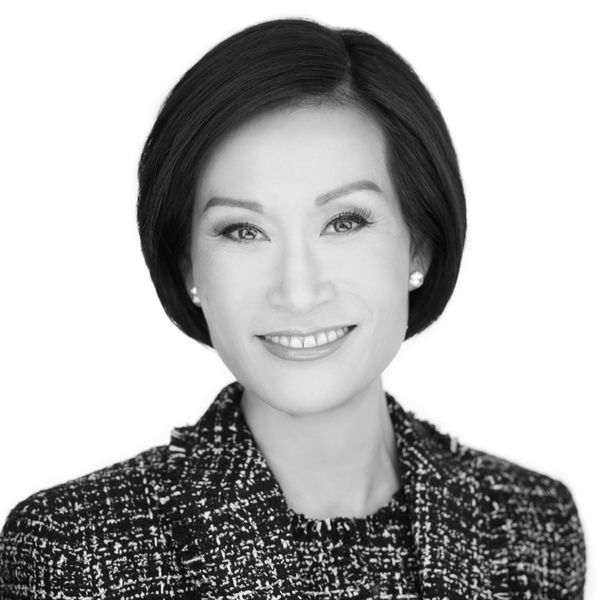Trending Now
We have updated our Privacy Policy and Terms of Use for Eurasia Group and its affiliates, including GZERO Media, to clarify the types of data we collect, how we collect it, how we use data and with whom we share data. By using our website you consent to our Terms and Conditions and Privacy Policy, including the transfer of your personal data to the United States from your country of residence, and our use of cookies described in our Cookie Policy.

Listen: “Women make about 75% of all household consumption decisions, and control close to 100 trillion in wealth,” says Ida Liu, Global Head of Citi Private Bank. "Women can no longer be ignored."
On the latest episode of Living Beyond Borders, we look at the impact women have in 2022 on the U.S. and global economy.
After some progress in the number of women in leadership positions and running businesses, the COVID-19 pandemic saw a setback for millions of women, especially those responsible for childcare. We'll look at how they are faring, and the gains women around the globe stand to obtain in the coming years.
This episode is moderated by Tracy Moran, managing editor of GZERO's daily newsletter Signal; and features Ida Liu, Global Head of Citi Private Bank, and Isadora Seixas, Global Macro-Geostrategy Analyst at Eurasia Group.

Tracy Moran
Managing Editor, Signal, GZERO Media

Ida Liu
Global Head, Citi Private Bank

Isadora Seixas
Global Macro-Geostrategy Analyst, Eurasia Group
Transcript: Season 3, Episode 8: How closing the gender gap drives economic growth
Disclosure: The opinions expressed by Eurasia Group analysts in this podcast episode are their own, and may differ from those of Citigroup Inc and its affiliates.
Isadora Seixas: There's a multiplier effect in women's advancement, similar to the multiplier effect in economics. // And studies have shown that when companies increase employment and leadership opportunities for women, they reap the benefits in areas like organizational effectiveness and growth.
Ida Liu: women make about 75% of all household consumptions decisions, and //control close to 100 trillion in wealth. So women can no longer be ignored.
Tracy Moran: Welcome to Living Beyond Borders, a podcast from Citi Private Bank and GZERO Media. On this program, we examine global risks and opportunities from the angles of both politics and economics. I'm Tracy Moran, managing editor of GZERO's daily newsletter signal. In 1995 at a UN conference on women's rights, then first lady, Hillary Clinton famously said this.
Clinton: “If there is one message that echoes forth from this conference, let it be that human rights are women’s rights are women’s rights are human rights.”
Tracy Moran: More than two decades later, there have been some signs of progress for women and girls globally, but the pandemic brought two major setbacks, especially in the workplace. In the US, at least 2 million women left the workforce, bringing their participation in the labor market to its lowest level since 1988. Still studies show that when women work societies reaped the benefits, in fact, McKinsey reported that closing the gender gap could add as much as 28 trillion to global GDP. We're going to talk about how to achieve that today. I'm joined now by Ida Liu global head of Citi Private Bank. Hi Ida.
Ida Liu: Hi Tracy. It's great to be on.
Tracy Moran: And Isadora Seixas, global macro geo strategy analyst at Eurasia group. Hi Isadora.
Isadora Seixas: Hi Tracy. I'm happy to be here.
Tracy Moran: Ida. Let's start with you. We saw so many headlines during the pandemic about women dropping out of the workforce. Where are we now in the recovery? Have women returned to work? Are things back to so-called normal?
Ida Liu: Well, we've all heard about the great resignation and the disproportionate impact on women. And it's not a surprise at all because we've heard that many of the women have been working so-called triple shifts. In some cases as a caregiver, in some cases, as a virtual educator plus their full time job. It's not surprising that there's been a disproportionate impact on women due to burnout. But we are seeing that the number of women with jobs now is higher than at any point since the COVID pandemic began, although it's still well below pre pandemic levels, so things are not quite back to normal yet.
Ida Liu: And women are lagging in returning to the workplace nationwide because of that double, triple hat that I was just talking about, but we're super focused on supporting our team's health and wellness and offering caregiver support and additional caregiver support for many of our employees to ensure that we're supporting our female colleagues around the world and taking some of that weight off the shoulders. And we're also making sure that we're thinking about retention and promotion of our female talent by creating different types of networks, sponsorship, and mentorship opportunities to keep everyone engaged and supported.
Tracy Moran: And Isadora. What have you seen in terms of the impact of COVID on women in the workforce? Not just in the US, but globally?
Isadora Seixas: Well COVID 19 dues disrupted labor markets around the world, but women were the one's hardest hit. The international labor organization reported that employment loss globally in 2020 was 5% for women, but only 3.9% for men. And that decline is going to last for a very long time because of underlying systemic inequities. For example, women around the world face restrictive gender norms that minimize their autonomy and mobility. They do a disproportionate amount of unpaid care work. They aren't allowed to access certain jobs or certain sectors, and they have less access to certain resources than men do like financial services, education, or technology. Some of those issues are greater in developing countries, but even in the US, we saw that job losses hit women harder than men during the pandemic. That was true for all education levels, but non college educated women were the hardest hit.
Tracy Moran: Ida. Why is increasing the number of women in leadership so important in the financial world in particular?
Ida Liu: Well, one thing is absolutely certain. We've completely shattered the glass ceiling here at Citi with the first female CEO, Jane Fraser, running a global financial institution. And I truly believe that seeing is believing. And I think she's done that brilliantly for all of us here at Citi and more broadly across the industry. I'm also very proud to share that we have 50% of our employees globally are women. And 50% of our board are women as well, and that's industry leading. And we think it's incredibly important because women make up a majority of financial services, industry employees, and the sheer of female executives are going to grow from 22% today to almost 31% by the end of this decade. We absolutely view having women and female representation and frankly in diversity as well as a huge strength for us in our organization.
It drives a lot of innovation, creativity, and I'm particularly proud in the private bank we're almost 50% women and my leadership team is 40% diverse. I think it is because we are so diverse that we have so many different perspectives around the table and our clients love the fact that we look like them. And I think it's very important that we mirror the clients that we serve around the world, which are extraordinarily global clients. One of the clients recently said to me that they felt that our team resembled the United Nations, and I took that as a huge compliment because I do value very much the multiple perspectives, the diversity and inclusive nature of our teams brings to the table.
Tracy Moran: Ah, that is encouraging. Isadora, have you also seen this trend globally? Are the numbers of women in leadership positions going up like in the financial sector or in other leadership areas like government?
Isadora Seixas: Yes, for sure. In 2021, the proportion of women in leadership roles in financial services firms was 24% and it is projected to grow to 28 by 2030. While this is certainly an improvement, it is still below parity with men and it's not increasing as quickly as many would like. Within the S&P 500 financial institutions, women are projected to field 37% of CSU roles by 2030, up from 32 in 2021. But that increases partly due to the growth of nontraditional CTI roles, such as chief diversity and inclusion officer, chief innovation officer and chief sustainability officer, where women tend to have higher representation, but which might not commend the same import as the more traditional roles. When you look at the government spheres, things are even worse.
The data shows that women are underrepresented at all levels of decision making roles worldwide and achieving gender parity in politics is far off. For example, as of September 1st, 2021, there were 26 women serving as heads of states and or government in 24 countries out of over 200 countries in the world. At the current rate, the UN forecast that gender equality in the highest position of power will not reached for another 130 years.
Tracy Moran: What do we know about the impact this has had?
Isadora Seixas: Well, there's a multiplier effect in women's advancement, similar to the multiplier effect in economics. So for example, within financial services firms, for every women added to the CSU in an organization, roughly three more women rise to senior leadership roles. This is one of the most important reasons why financial services firms should bolster their efforts to achieve gender equity. And studies have shown that when companies increase employment and leadership opportunities for women, they reap the benefits in areas like organizational effectiveness and growth. In government there is growing evidence that women's leadership improves political decision making processes. Women demonstrate political leadership by working across party lines through parliamentary women's caucuses, even in the most politically combative environments. And they champion issues of gender equality that have far reaching public impact, such as elimination of gender based violence, pensions, gender equity laws, electoral reforms, parental leave, and childcare.
Tracy Moran: And Ida, we know that women are not only having an impact on the financial world, but other huge sectors of the economy like technology, small business, et cetera. What other trends are we seeing? What about the informal economy?
Ida Liu: Well, women are making dramatic strides in entrepreneurship, female participation in the entrepreneurial spaces, almost 80% the rate of men globally, which is meaningfully higher than the 50% it was 20 years ago. But unfortunately most of this increase is driven by developing countries where women have difficulties finding employment in the formal economy. But as for technology, there's still huge barriers for women, with only 2% of entrepreneurs receiving venture capital funding when you are a woman. So as you can see, huge barriers to entry still there. However, women today control almost 100 trillion of the global wealth. That's almost a third of global wealth, which is an incredibly important number and growing. And as you can see from the number of very successful female entrepreneurs, including the number of female billionaires that have been created over the last several years, today at 327 female billionaires growing steadily over the last several years, you can see that more women are controlling more wealth, which will then equate to moving the needle for us across the board.
Tracy Moran: And why is gender lens investing so important and impactful?
Ida Liu: Oh, it's so incredibly important because if you think about it, diverse managers represent a segment of the market that has consistently demonstrated the opportunity to secure alpha and outsize returns relative to industry benchmarks and public market equivalents. But we're at an inflection point today where there's a large investible universe of exceptional talent that is underbanked and many have been cycle tested demonstrating the ability to generate alpha for investors. And today, only 1.4% of assets are entrusted by investors to asset management firms owned by women and or people of color, that's 1.4% today, but yet companies with greater gender diversity are 25% more likely to experience above average profitability compared to their counterparts. And for cultural and ethnic diversity on top of that, that number was 36% more likely to show above average profitability.
On the alternative side, the average earnings growth of portfolio companies with two or more diverse board members, including women has been nearly 12% greater per annum than the average of companies that lack diversity. So those are pretty compelling statistics and what the message is here is that you simply don't have to trade off doing good with great returns, and many investors are focused on purpose driven investments, including the gender angle.
Tracy Moran: And Isadora, what are we seeing now outside of COVID in the pandemic recovery, in terms of the gains women around the world have made towards economic equality, and what kind of impacts have they had on the economies of countries around the world?
Isadora Seixas: There has suddenly been progress on generic equality over the last few decades. More girls are going to school, fewer girls are forced into early marriage, more women are serving in parliament and positions of leadership and laws are being reformed to advance gender equality. Increased educational attainment accounted for about half of the economic growth in OECD countries over the past 50 years. But for most women, those educational gains have not translated into better labor market outcomes. So there is a lot of work still to be done. For example, women still perform 75% of the roles unpaid work, three quarters of the work done by roughly half of the people. So women are effectively subsidizing the global economy. They do 60% more household work than men, and they perform the vast majority of unpaid care work for children, the elderly and the sick. And more time spent on unpaid work means less participation in the labor force.
In countries where women average five or more hours per day of unpaid work, only up to half of them are employed or seeking formal sector employment. In pilot studies performed in Mexico and other parts of Latin America, we could see that where childcare was provided on the large scale, there was a huge increase in female labor force participation. So that is a lot of evidence of the real benefits of providing universal care.
Tracy Moran: Ida, Citi has looked at a number of unstoppable trends, from the greening of the world to digitization. How do you see women impacting those other trends that Citi is watching?
Ida Liu: Well, for one thing, there is a very strong representation of women in industries that are most likely going to be affected by automation. So by 2030, an estimated 100 million women may need to transition into higher skilled roles, necessitating higher education or upskilling. And to the extent that digitization and the expansion of 5G connectivity, democratizes information and lowers the cost of education eLearning will be a key tool for raising welfare standards of women throughout the developing world. Interestingly, women are also poised to be the greatest innovators and greening of the world, and according to a study recently done by the United nations, women are more likely to be impacted by climate change. And in fact, approximately 80% of people displaced by climate change related disasters are women. So we strongly believe that empowering women through improved education and work opportunities will amplify their power to affect a greener world. And women indeed are the ideal change agents, very resourceful, I think in finding solutions for their families and as key decision makers.
Tracy Moran: Where are problem areas? Places where you see there still is a lot of work that needs to be done?
Ida Liu: Well, we truly believe that what gets measured gets done and we need to hold leaders accountable for moving the needle as it comes to progression for women. I think we've made substantial progress already in the formal economy on equal pay on some employment opportunities, the access to childcare and parental leave policies. Here at Citi, we were the first global financial institution to release our gender pay gap numbers almost four years ago. And we did that intentionally because as I said earlier, what gets measured gets done, and we wanted to hold ourselves accountable, put the numbers out there and make sure that we don't stop until that number is at parity, which I'm very pleased to say that we are almost at parity now. So I think it is important for us to continue to do that, to measure progress, to hold leaders accountable for moving the needle, to make sure that we have very diverse interviewee slates and interviewer slates so that we can bring more diverse talent into organizations and foster a more inclusive environment.
Tracy Moran: Isadora, when we think about some of the gaps, which can be solved by some economic changes or business trends and which really need governments or policy to get involved.
Isadora Seixas: Well, to address issues like gender inequality, we need governments to get involved and provide policies that ensure greater coverage of women. Such policies should be universal, gender responsive and independent of labor market trajectories or prior contributions to social security programs. We've recently worked wellness study with the Gates Foundation that show that global GDP would be increased by an average of 3 trillion each year if all women had access to free childcare. This increase would steam directly from value created by women who would join the labor force, which to better access to childcare. Looking at the US specifically, such policies became even more important now in light of their recent Supreme Court decision to overturn ROE v Wade. As abortion is made illegal in some states, more support should be provided to expected mothers, especially from low income families, but still several states do not offer state child tax credits or any protections for pregnant workers.
And many also have lengthy waiting list to receive funds from the Childcare and Development Block Grant Program, which provides subsidies to qualifying low income families. Researchers predict that the vacuum of support will exacerbate inequality, particularly in the wake of a pandemic that has already worsen a gender wealth and racial disparities. This scenario makes it harder for women to gain economic security, to get ahead, to gain wealth. The ruling breaks renew urgency to enactment of care policies like paid leave, childcare and protections for pregnant workers at the federal level. Other policies like instituting cash transfer programs globally could lift 55 to 100 million women out of absolute poverty, which is defined as living on less than $1.90 per day. The private sector should also step up and contribute to closing the gender gap by implementing policies that not only ensure equal pay, but also address bias in recruitment process that places women at disadvantage. Businesses in general should view pay equity and gender balance, not only as moral imperatives, but also as economic opportunities.
Tracy Moran: What are some areas of hope coming in the next few years?
Isadora Seixas: There are certainly some interesting initiatives to improve gender equality and women's economic empowerment coming from both the public and private sectors, as well as from multilateral institutions. For example, the UN established the High Level Panel on Women's Economic Empowerment to address the specific economic issues that affect women and to support the implementation of the 2030 agenda for sustainable development. And it's promised to leave no one behind, which includes eliminating gender inequality. The panel has outlined an action agenda to accelerate progress with key steps tailored to different sets of factors, including governments, businesses, civil society, development organizations and thought leaders. And they recognize the diversity of conditions in which different stakeholders operate. There is also a lot of progress being made with initiatives to boost the participation of women in STEM fields, as a mechanism to bridge the gap between social justice and academic careers. These measures vary from targeting school-aged girls to increasing awareness of such field from our young age, to funding scholarships to women that want to pursue a career in this field.
Tracy Moran: Ida, what about you? What are you looking for in the next few years in terms of the impact women can have on the economy?
Ida Liu: Well, throughout this conversation, we've highlighted the incredible impact that women have on the economy. And we've also highlighted the potential for even greater impact by fully investing in women, and in the Private Bank, one of our key client segments is a focus on our female clients. In fact, women make about 75% of all household consumptions decisions, and as I mentioned earlier, control close to 100 trillion in wealth. So women can no longer be ignored. And the rise in services, the global value change and the digital economy has expanded women's roles in the economy, decreased inequality and expanded women's access to skills and education. And in fact, a Citi study found that by attaining 100% secondary school completion rates by girls in 2030 would lift the GDP in emerging economies on average by 10%. So again, just by education of women and girls in secondary school that we could lift GDP in a emerging economy is a 10%. It's absolutely critical that we invest in women from a very young age, and gender equality is an imperative and women's economic empowerment drives a social and economic multiplier benefit.
Tracy Moran: Ida Liu, global head of Citi Private Bank and Isadora Seixas, global macro geo strategy analyst at Eurasia Group. Thanks to you both for being here.
Ida Liu: Thank you so much for having us.
Isadora Seixas: Thank you.
Tracy Moran: And that's it for this episode of living Beyond Borders, stay tuned for more throughout the summer as we continue to track major trends like the shifting US-China relationship. To listen to previous episodes, head to gzeromedia.com and click on the Living Beyond Borders tab, or subscribe wherever you get your podcasts. For GZERO, I'm Tracy Moran. Thanks for listening.
- S3 Episode 6: Economic weapons & fallout of the new Cold War ... ›
- S3 Episode 1: If the economy is good, why do I feel so bad ... ›
- S3 Episode 3: Will there be a recession? - GZERO Media ›
- S3 Episode 5: Could today's crisis lead to future growth? - GZERO ... ›
- The economic power of women - GZERO Media ›
- Episode 3: Inflation Nations: What to know about inflation and interest rates - GZERO Media ›